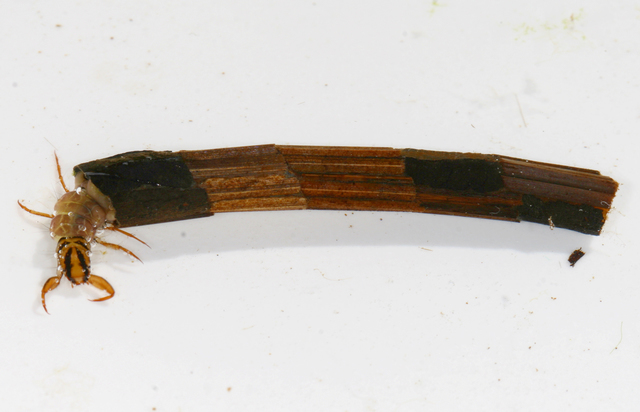The genus name Phryganea has a long history of use, starting in the 10th edition of the Systema Naturae (Linnaeus 1758). Carl von Linne included 17 species of caddisflies in this work, all under the genus Phryganea (from the French word for caddisflies). Needless to say, most of these species have been removed to other families and genera. At the time, caddisflies, stoneflies, dragonflies and mayflies were all included under the order Neuroptera; it wasn't until 1813 that the Order Trichoptera was erected. Due to the original status of the genus, there are many nomenes dubius and synonyms that by far outnumber the species now in the entire family.
In addition to large size (often greater than 25 mm), the adults are characterized by colorization ranging from the black and white checkers of Banksiola to the fall leaf orange of Ptilostomis to the yellow and dark purple of Eubasillissa. The largest species, Eubasillissa regina, is over 4 cm with an 7 to 8 cm wingspan. Dr. John Morse, who has spent much time collecting and studying aquatic insects in Southeast Asia, told me they look like a small bird with a strange flight pattern from afar.
The larvae often have contrasting patterns of orange and black stripes on head and thorax, and are just as impressive as the adults in size. One of the most curious larval tendencies is the ease at which they leave their cases behind when disturbed. If one larva looses it's case and other of a similar size is occupied nearby, the two larvae will fight over the case (as illustrated in this video). Though they inhabit a wide variety of aquatic habitats, they are found most often around the roots and stems of aquatic vegetation, and in root balls of woody plants, with a diet of mostly aquatic invertebrates.
The definitive guide for the family is an eponymously named book by Glen Wiggins (1998), and despite being over ten years old is still in print and in demand. The book includes genus keys and diagnoses for all the species know at its publication, including all 28 North American species. Wiggins splits the family into the Yphriinae (which includes a single species of Yphria from Western North America), and the Phryganeinae, though the separation is drawn due to 'primitive characters' possessed by Yphria is to me not particularly convincing, and may be paraphyletic.
References
Morse, J.C. (ed.) 2011. Trichoptera World Checklist. http://entweb.clemson.edu/database/trichopt/index.htm [Accessed 24 October 2011.]
Wiggins GB. 1977. Larvae of the North American Caddisfly Genera. University of Toronto Press, Toronto, ON.
Wiggins, G.B. 1998. The Caddisfly Family Phryganeidae (Trichoptera). University of Toronto Press, Toronto, ON.




No comments:
Post a Comment